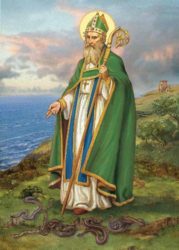
What do Irish wear?
When I was growing up, our Roman Catholic family, like many others, celebrated St. Patrick’s Day by wearing something green. I think the green theme comes from the green shamrocks that famously grow in Ireland. (And maybe the green eyes in the Irish gene pool). My mother’s mother was Irish, and with various shades of red hair distributed throughout our family’s DNA, my four Keefe cousins (my mother’s sister married a red-haired Irish guy) were more unmistakably Irish than me, although I sport the wide-spread freckled skin and green eyes common among the Irish folk.
At school—St. Francis de Sales—on St. Pat’s day, I often wore a little green ribbon in my hair, but a green sweater was usually a better tribute. The nuns often rewarded our good grades with Holy Cards (playing card-sized portraits of saints) and I had one that depicted St. Patrick decked out in priestly garb, holding shamrocks and fending off snakes, not unlike the feature photo.
Who was this Irish St. Patrick?
“Saint Patrick was a fifth-century Romano-British Christian missionary and bishop in Ireland. Known as the “Apostle of Ireland”, he is the primary patron saint of Ireland.” Source: Wikipedia.
Fun facts: St. Patrick’s Day
From the History website:
- The first St. Patrick’s Day parade took place in the United States on March 17, 1762, when Irish soldiers serving in the English military marched through New York City.
- There are 34.7 million U.S. residents with Irish ancestry. This number is more than seven times the population of Ireland itself.
- Corned beef and cabbage is a traditional St. Patrick’s Day dish. In 2009, roughly 26.1 billion pounds of beef and 2.3 billion pounds of cabbage were produced in the United States.
- There are seven places in the United States named after the shamrock, the floral emblem of Ireland including Mount Gay-Shamrock, WV; Shamrock, TX; Shamrock Lakes, IN; and Shamrock, OK.
What about those Irish snakes?
Again, the History website:
“St. Patrick, the patron saint of Ireland, is one of Christianity’s most widely known figures. But for all his celebrity, his life remains somewhat of a mystery. Many of the stories traditionally associated with St. Patrick, including the famous account of his banishing all the snakes from Ireland, are false, the products of hundreds of years of exaggerated storytelling.”
Exaggerated storytelling? Nah, not the Irish!
A couple of years ago, Hoyt and I visited lush green Ireland. In Dublin we stopped in The Dublin Writers Museum where I paid homage to the great Irish poets and writers, like William Butler Yeats and Oscar Wilde. Loved it. Maybe the Irish blood in my veins has something to do with my love of stories and of writing them. Coincidentally, the book club I am part of is currently reading the famous James Joyce’s Dubliners. It’s a collection of short stories depicting the colorful and the drab lives of people living in Dublin at the turn of the century (19th). He wrote the stories (most in 1905) from the far distance of Trieste, Italy. Sometimes putting a great distance between yourself and the people and places about which you are writing is the only way you can manage a creative act.
Escape to Ireland
Here are a few of my tales of Ireland.
Our far-flung visit to Ireland
Cheers!







Linda Goddard
Charlene,
Thank you for your remembrance of the Irish.
My grandparents were born and raised in Ireland, and I am pursuing Irish citizenship. I have family there, whom I’ve never yet met, but a visit there is number one on my list!
If you don’t know of St. Brigid of Kildare, look her up. She was a contemporary of St. Patrick but doesn’t seem to get the recognition that I think she deserves.
Sending you an Irish wish this morning! Linda
Charlene L. Edge
Hi Linda,
So sorry for this late reply. I will check on St. Brigid. Ain’t it a pattern … the women get overlooked?